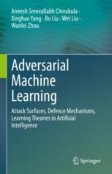Search
Search Results
-
Towards a Competitive Two-Player Anti-phishing Learning Game
This paper explores the design and implementation of a competitive two-player anti-phishing learning game on the topic of phishing emails, aiming to...
-
Outsider Key Compromise Impersonation Attack on a Multi-factor Authenticated Key Exchange Protocol
Authenticated key exchange (AKE) protocol is a security mechanism that ensures two parties communicate securely on a public channel and keeps the...
-
Game Theoretical Adversarial Deep Learning
This chapter summarizes the game theoretical strategies for generating adversarial manipulations. The adversarial learning objective for our...
-
Impostor GAN: Toward Modeling Social Media User Impersonation with Generative Adversarial Networks
The problem of “fake accounts” on social media has gained a lot of attention recently because of the role they play in generating/propagating...
-
Asymmetric Centrality Game Against Network Epidemic Propagation
The Mirai botnet network epidemic discovered in 2016 falls into the category of numerous epidemics propagated by attackers over a network to gain...
-
A secure elliptic curve based anonymous authentication and key establishment mechanism for IoT and cloud
Abstract
With the increased number of smart devices in IoT and cloud, communication messages are exchanged extensively throughout the network. This...

-
Digging Deeper: An Analysis of Domain Impersonation in the Lower DNS Hierarchy
Attackers use various techniques to lure victims to malicious domains. A typical approach is to generate domains which look similar to well-known...
-
REACH: Robust Efficient Authentication for Crowdsensing-based Healthcare
Crowdsensing systems use a group of people to collect and share sensor data for various tasks. One example is the crowdsensing-based healthcare...

-
Development and analysis of attack-resilient three party authenticated key agreement scheme based on chaotic maps for secure communication
The three party authenticated key agreement protocol assists two parties in affirming one another and agreeing on a shared session key with the...

-
Quantum-secure content key delivery mechanism for DRM system
As a result of the development of digital and internet technologies, digital content theft has become a major problem for the multimedia industry....

-
The Genius of the 'Original Imitation Game' Test
Twenty years ago in "Turing's Two Tests for Intelligence" I distinguished two distinct tests to be found in Alan Turing's 1950 paper "Computing...

-

-
A multi-layered security model to counter social engineering attacks: a learning-based approach
Social engineering is a malicious technique that leverages deception and manipulation to exploit the cognitive biases and heuristics of human...

-
Chaotic map based multi-factor authentication protocol for underwater environment monitoring
The underwater environment holds significant potential for advancing ecosystem understanding, industrial operations, and early natural disaster...

-
An anonymous and authenticated V2I communication with a simplified user revocation and re-registration strategy
Vehicle-to-Infrastructure (V2I) communication is the key requirement in various applications of Vehicular Ad-hoc Network (VANET). However, due to the...

-
A design of provably secure multi-factor ECC-based authentication protocol in multi-server cloud architecture
The emerging cloud infrastructure has escalated number of servers offering flexible and diverse remote services through public channels. However,...

-
Automated detection, categorisation and developers’ experience with the violations of honesty in mobile apps
Human values such as honesty, social responsibility, fairness, privacy, and the like are things considered important by individuals and society....

-
A provably secure lightweight authentication protocol in mobile edge computing environments
Mobile edge computing can meet the needs of users in real time by pushing cloud resources, such as computing, network, and storage, to the edge of a...

-
A novel ECC-based provably secure and privacy-preserving multi-factor authentication protocol for cloud computing
The widespread adoption of cloud computing enables the end-users to leverage convenient sharing, unlimited storage and on-demand access to big data....

-
Exploring Different Game Mechanics for Anti-phishing Learning Games
Existing anti-phishing learning games rely on the same simple game mechanics that do not allow for detailed assessment of the players’ acquired...
